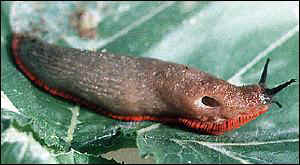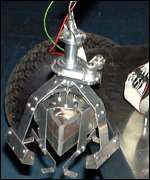| SlugBot - Robotic Hunter For The Garden |
|
||||||||||
|
Stiquito Kit BattleKits Robot Toys Solar Kits Robot Arms Robosapien Basic Stamp Kits Lego MindStorms
Hobby Robots Robot Sports Electronics Mechanics Robot Minds Books for Kids Robots at Work Microcontrollers Advanced Books Used Books
Robot Motors Remote Controls Robot Parts Robot Tools Magazines Robot Videos Robot News RoboLinks Contact
|
Courtesy BBC News Not the gardener's friend: The black slug By Environment Correspondent Alex Kirby Scientists in the United Kingdom are developing a prototype robot slug-destroyer, which draws its power from the decomposing bodies of its victims. The scientists are members of the Intelligent Autonomous Systems group of the engineering faculty at the University of the West of England, in Bristol. They hope their work, which is funded by the Engineering and Science Research Council and reported in Farmers Weekly, will be ready for field trials early next year. The prototype, named SlugBot by its inventors, consists of a 45 cm-square aluminium box containing a bank of low-powered electric motors, with a wheel at each corner. On top of the box sits a turntable-mounted carbon fibre arm, with a reach of 1.8 metres. No hiding place The arm ends in a three-fingered gripping device fitted with scrapers for wiping off slug remains and slime. It also includes an image sensor to scan for prey.
The sensor is equipped with a red filter to help detection: when SlugBot shines a red light onto the ground, the creatures show up as white blobs on a dark background. The slugs' images are checked by optical shape recognition software, and when a match is found the molluscs are dropped into a hopper, at a maximum rate of 10 slugs a minute. Rechargeable batteries and the control mechanism are placed behind the turntable to balance the weight of the arm.
Fuel from corpses The intention is that when the hopper is full, or battery power low, SlugBot will find its way back to a base unit, using a combination of the differential global positioning satellite system and an active infra-red localisation system.
At the base, the slugs will be transferred into a fermentation chamber where bacteria convert them into bio-gas, which is used to load a fuel cell to produce the electricity to power SlugBot's batteries for its next foray. The cost of the prototype's components was less than £1,500, and a production model could cost much less. And there should be no shortage of prey. Up to 200 slugs per square metre are found in fields of winter wheat. Dr Chris Melhuish, a senior team member, told BBC News Online: "This is a serious, long-term piece of work, and at the moment it is at the experimental stage. "What we are involved in now is proving the concept, making sure the different elements will work. If they do, it could have important implications."
|
||||||||||
|
Advertise your product on RobotBooks.com Beginners Books |
Hobby Robots |
Robot Sports |
Electronics |
Mechanics |
Robot Minds |
Robot Fiction |
|||||||||||


